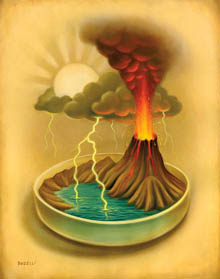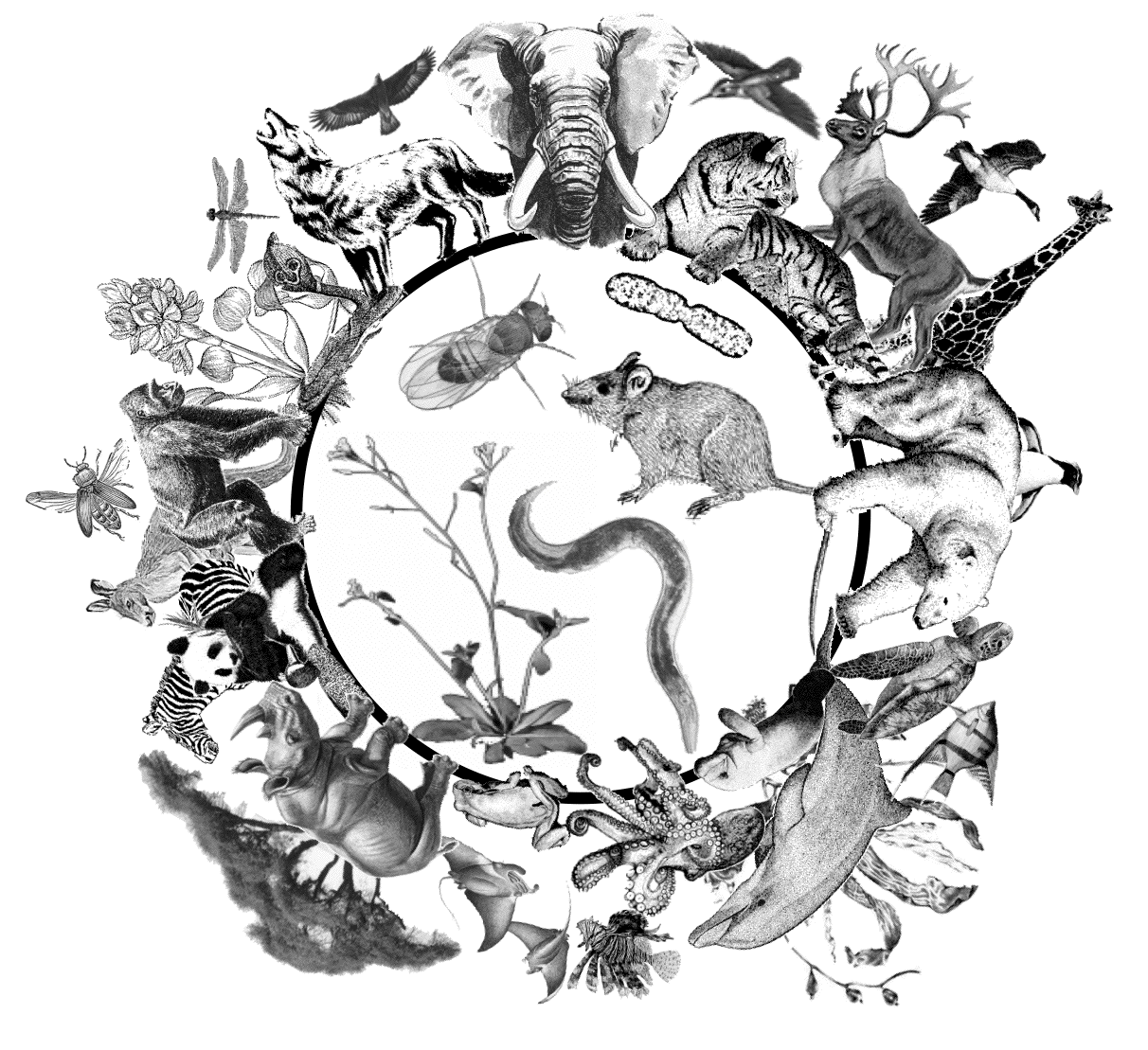 In 1902, Georges Méliès directed “A Trip to the Moon” (in French: “Le Voyage dans la Lune”) and for the first time, audiences watched fanciful moments of humans interacting with extra terrestrials. The imagination of the world was captured, successive generations of filmmakers followed suit, and with it ushered in a wave of new ideas that still dominate the entertainment industry today. Putting aside the entertainment value, is there any scientific value to the idea of extraterrestrials and what does it tell us about evolution?
In 1902, Georges Méliès directed “A Trip to the Moon” (in French: “Le Voyage dans la Lune”) and for the first time, audiences watched fanciful moments of humans interacting with extra terrestrials. The imagination of the world was captured, successive generations of filmmakers followed suit, and with it ushered in a wave of new ideas that still dominate the entertainment industry today. Putting aside the entertainment value, is there any scientific value to the idea of extraterrestrials and what does it tell us about evolution?Of course we all know this guy… Carl Sagan. Wait, if you don’t know him, look him up. He’s quite fascinating and we owe him a great deal of thanks and appreciation for his ability to get the American public and the world to be interested in science. He also got us interested in some pseudoscience-ish stuff alongside the science, but for the most part he was great!
He was instrumental in the founding of S.E.T.I. which is the scientific endeavor of Searching for Extra Terrestrial Intelligence. It used to be funded by the U.S. Government, but public funds are no longer used to support the search. Sagan was interested in searching for intelligent life because he believed its existence was a numbers game. With all of the billions and trillions of solar systems in the Universe, he thought there must be life out there as intelligent as us. A colleague of Sagan’s by the name of Frank Drake developed an equation that was used to estimate the number of intelligent extraterrestrial civilizations and it produced a number that made the idea of S.E.T.I. a “no brainer.” In our galaxy alone, Drake estimated there would be ten civilizations that are capable of broadcasting a signal. Adding this information to the number of galaxies in the universe, of which NASA estimates between 100 and 200 billion, and according to Drake’s equation there should be trillions of civilizations that are broadcasting, which confirms Sagan’s numbers game.
So, where is everybody? Why have we not heard anything? Where are all of the extraterrestrials? Why have we not received a probe from some other civilization? We have put multiple probes on Mars and back in the 1970’s we launched the Voyager Interstellar Mission. In fact, Voyager 1 is the fastest moving object ever created by humans with a speed of 38,600 mph. If we can send probes, what about the other “trillions” of civilizations out there? This problem is considered the Fermi Paradox.
Distance is the problem right? It would just take way too long. Well, according to the National Academy of Sciences and the work done at NASA through the Kepler Mission, the closest Earth-like planet is 12 light years away. Knowing that light travels at 186,000 miles per second and there are 31,536,000 seconds in a year; 12 light years equals 70,388,352,000,000 miles. A probe traveling at the same speed as Voyager 1 could travel 12 light years in 1,823,532,435 hours or 208,165.8 years. Of course, we are not talking about anything being plausible for a single human lifetime, but over the course of deep time, a couple hundred thousand years is nothing. Also, keep in mind that Voyager 1 was one of our first attempts at sending an interstellar probe and it moves fast. In the future, we hope to go much faster, but let’s keep current numbers for the sake of this article.
What does this information tell us about extra terrestrials? Remember, the Earth is young in comparison to other formations in space. Most scientists agree the Earth is 4.5 billion years old and the Milky Way Galaxy is 13.2 billion years old. So, if another earth-like planet exists and it is just slightly older than our planet, say 4.6 billion years old… it could be up to 480 light years away and the intelligent civilization on said planet would still have enough time to send a probe to us. Estimating the age of an Earth-like planet that hosts an intelligent, probe-sending civilization in our galaxy could be anywhere between 4.6 and 13.1 billion years old… my question is, where are all the probes? We can point our satellites at Voyage 1 and listen to it, why are we not hearing other probes from other civilizations? The Kepler Mission has generated data that shows, in our corner of the Milky Way, there are 603 Earth-like planets that orbit a Sun-like star at a proper distance to be deemed as “habitable.” So, where is everybody? The planets are out there, the time and distance make sense, but why are we all alone?
When it comes to S.E.T.I. and any other attempt/mission to find out if we are or are not alone in the Universe, what is the elephant in the room? What I mean is, there seems to be a huge assumption that everyone agrees with, but it is not being brought up. Yup, you guessed it… evolution. Take a look at Drake’s equation:
Life appearing (abiogenesis) and intelligent life emerging (evolution) are two hugely mysterious concepts of which science has no empirical data to support. The answer to the question, “Is there anybody out there?,” is a question. What logic is behind the search for extraterrestrial intelligent life if we know its existence is dependent upon abiogenesis and evolution of which do not have supporting empirical data?
Of course many folks would stop me and say, first, abiogenesis is not part of evolution and second, there is empirical data that supports evolution. My response to the first part would be: Isn’t life a necessary ingredient for life’s diversity? If evolution cannot take place without life, then wouldn’t you say the origin of life is kinda important? Darwin had pondered abiogenesis and even wrote about it in a letter to his friend Joseph Dalton Hooker. He said that life may have begun in a “warm little pond, with all sorts of ammonia and phosphoric salts, lights, heat, electricity, etc. present, so that a protein compound was chemically formed ready to undergo still more complex changes”. He went on to explain that “at the present day such matter would be instantly devoured or absorbed, which would not have been the case before living creatures were formed.” In other words, the presence of life itself makes the search for the origin of life dependent on the sterile conditions of the laboratory.”
Secondly, if there is empirical data in support of evolution, we must first ask the very poignant and important question of “What is evolution?” My book What Is Evolution? dives deep into this question. Seriously, what is evolution and why is it undefined by public school curricula and court case transcripts? If we could define evolution, clear away the clouds of confusion, and get the scientific community to agree upon the definition, then we could talk about what empirical data supports evolution.
As it stands now, evolution has no agreed upon definition so all conjecture surrounding empirical support for the idea is pointless. In my book, I offer a working definition based on many thoughts presented by prominent voices in the evolutionary community. With that working definition, I invite readers to explore empirical data and evolution. For example, what can science show us about evolution when it comes to the fossil record, extant organisms living today, homologies/visual similarities, pre-humans like the Neanderthal, mutation, genetic variation, vestigial remnants like whale hips, genetic complexity, DNA, our closest relative, and many other topics? If you are a human and you have ever wondered or questioned how that happened, you need to read my book, “What Is Evolution?”





